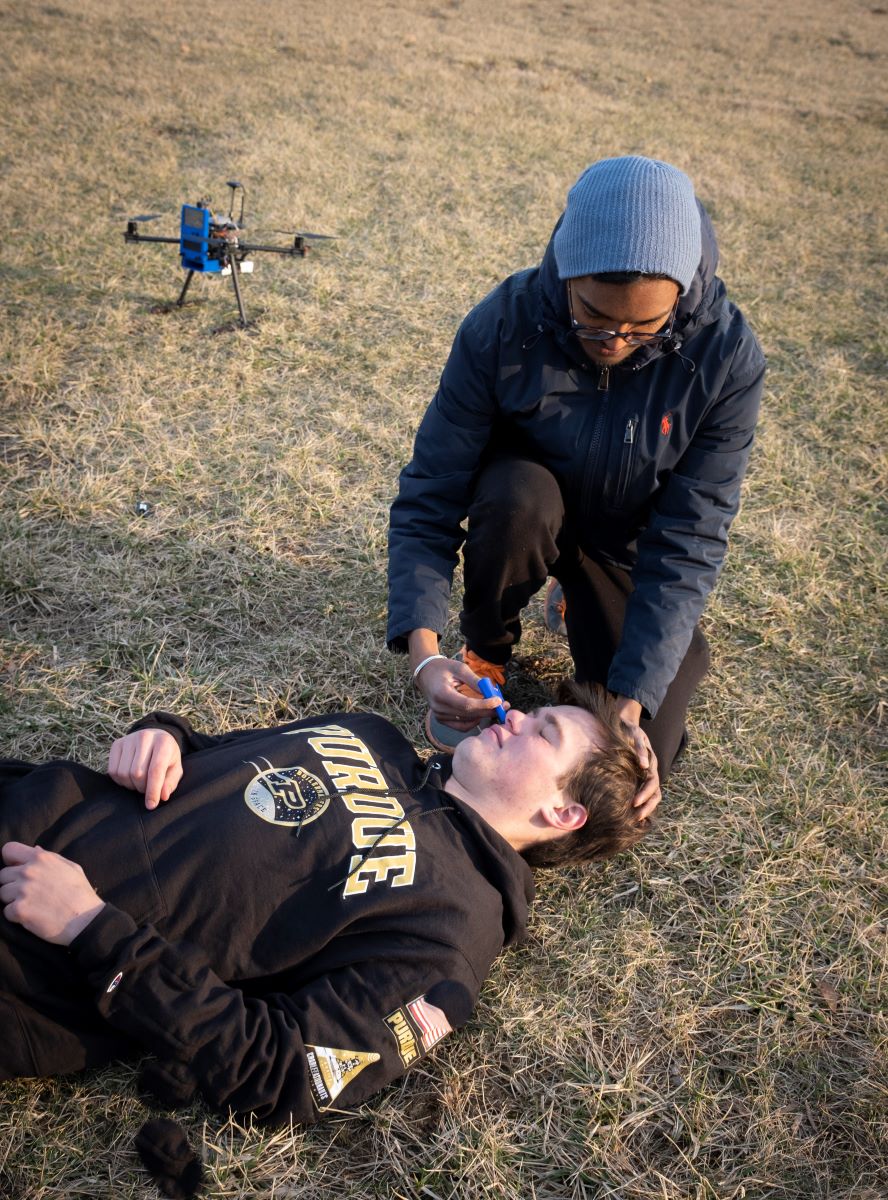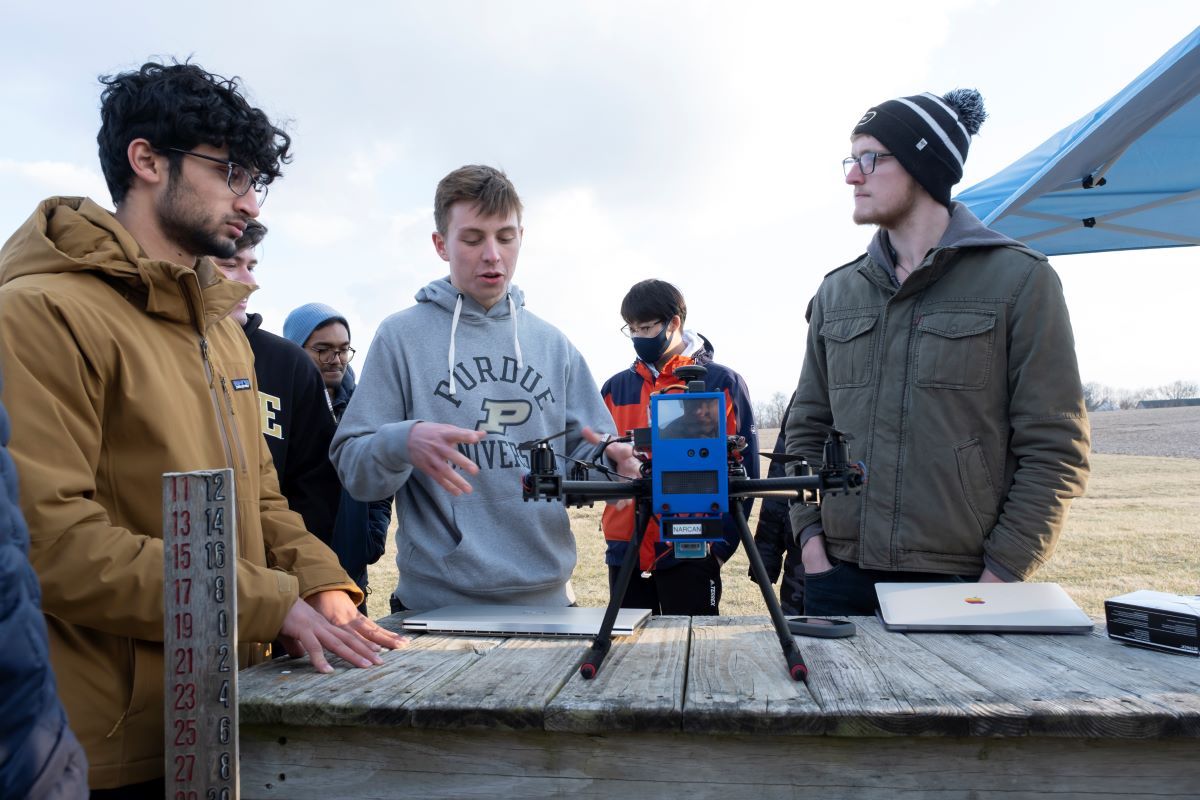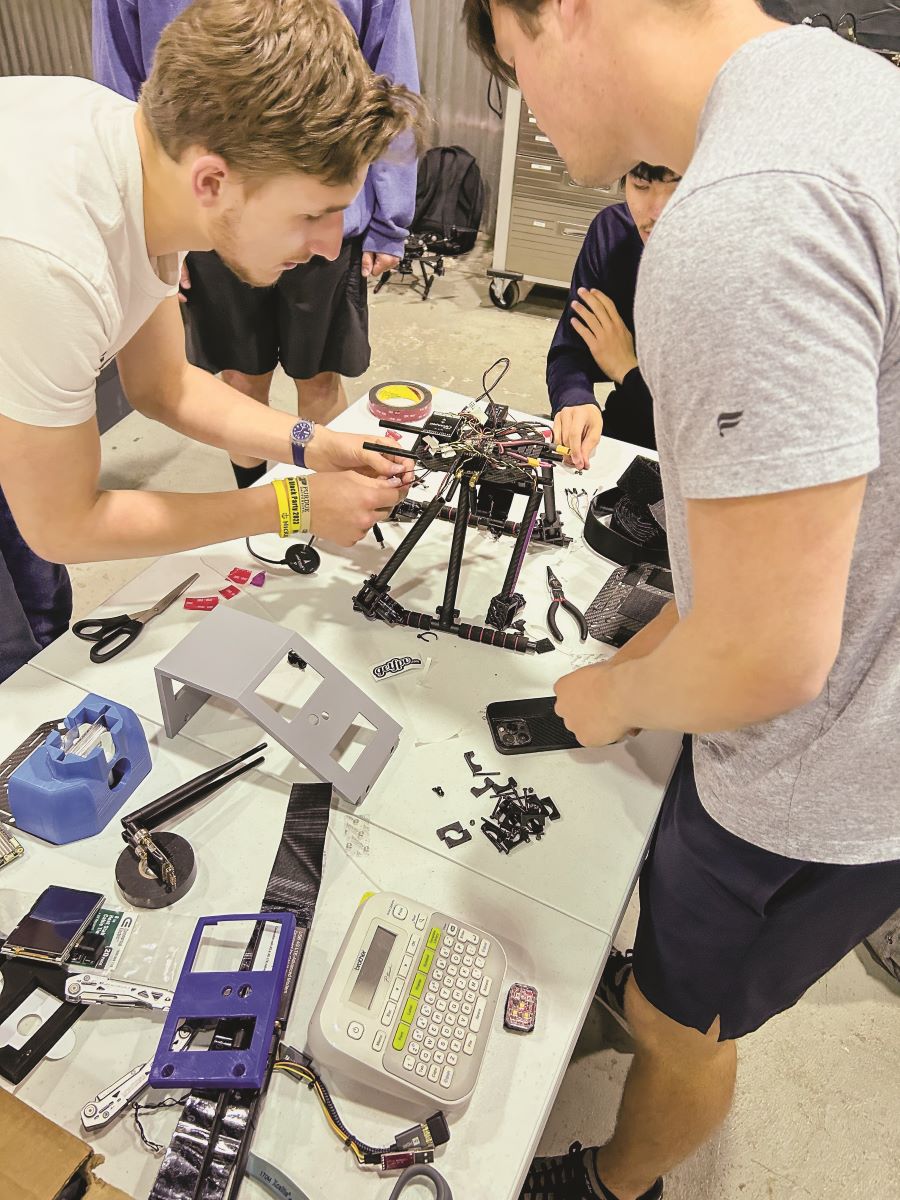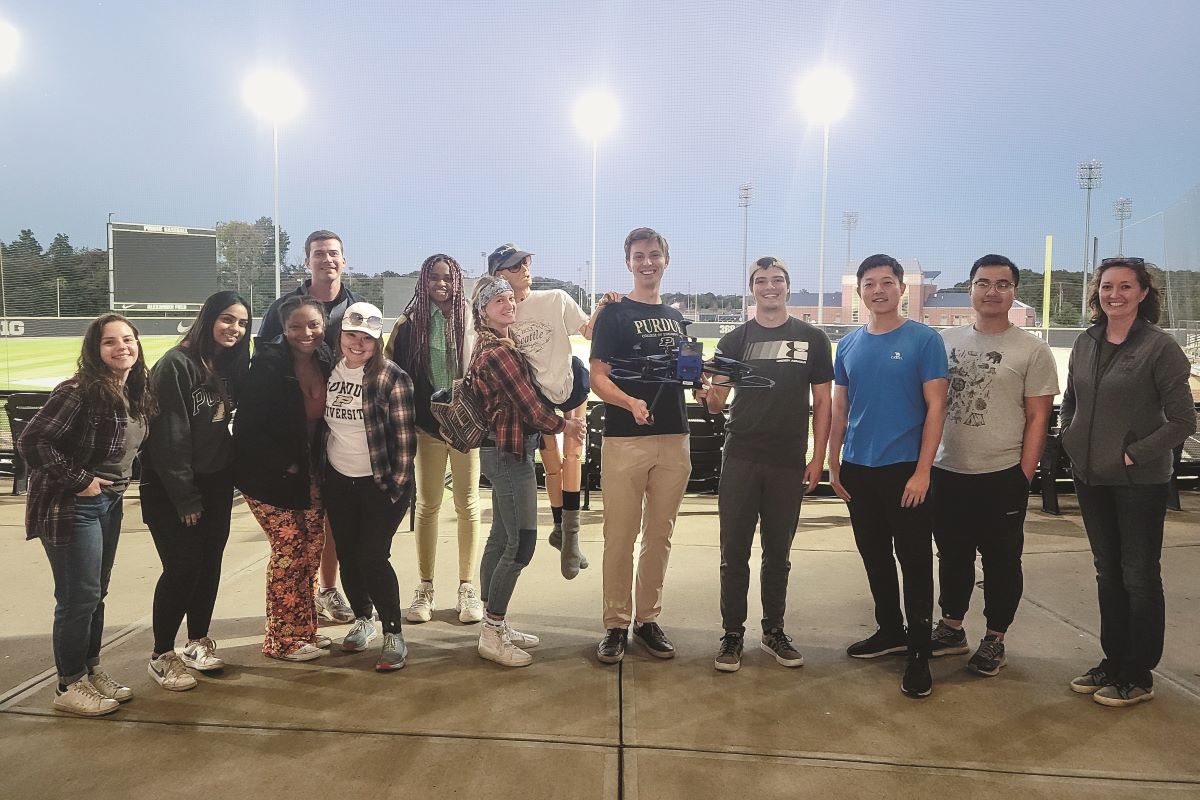
On a crisp afternoon in October 2022, a student walking on campus encountered an opioid overdose victim laying in the grass. A panicked bystander stood nearby, pleading for help. That help came in the form of a drone carrying Narcan nasal spray. The drones video screen and audio output instructed the student how to remove the canister and administer the medicine in time to save a life.
The simulated emergency scenario, conducted with a patient mannequin, was part of a pilot study led by Nicole Adams (BS Science '97), clinical associate professor of nursing, and Nan Kong, professor of biomedical engineering, to evaluate the efficacy and efficiency of an individual interacting with an autonomous Narcan delivery drone during a medical emergency.
"My research focuses on health care in rural communities," Adams says. "In rural areas, the median response time for an ambulance to arrive is 13 minutes and 10% of patients wait almost half an hour. When a person stops breathing, we only have six minutes until they die and cannot be resuscitated."
Adams stressed that drones would supplement ambulances, not replace them. And if proven effective, drones could become a routine tool to provide critical aid in a timely manner during medical emergencies. Although other institutions have run simulated studies involving drone delivery of Narcan, none involved human participants administering the medicine. Kong, whos collaborated with Adams on several projects in recent years, suggested they leverage the Vertically Integrated Projects (VIP) Program in the College of Engineering and partner to design an unmanned aerial vehicle (UAV) prototype that could be used for a drone-delivered Narcan feasibility study with human participants.
"In biomedical engineering, we address problems with the ambitious but clear goal to improve human health," Kong says. "I seek to bridge the gap between a domain expert, such as Dr. Adams, and our engineering students. The goals of this project have important social and economic relevance and I knew it would be a rewarding experiential learning opportunity for the students to apply their technological expertise to solve a problem with real-world impact."

Prior to the fall 2022 study at Alexander Field, the team held a practice run in March 2021 to test an initial prototype drone. They made additional modifications to the UAV based on that test.
In VIP, undergraduate interdisciplinary engineers work together in teams on authentic and extended research and design projects related to active research areas of Purdue faculty members and national, international and industry-sponsored design challenges. The Rural UAV Narcan (RUN) team also included nursing students.
"VIP provides a unique opportunity for students to collaborate with faculty and graduate student mentors to address real-world research and design challenges," says James Goppert (BSAAE '07, MSAAE '11; PhD AAE '18), managing director of the Purdue UAS Research and Test Facility (PURT). "VIP students get a jump-start onworking in industry and applying skills they are learning concurrently in the classroom. A lot of students discover a passion for robotics or programming they didn't realize they had. VIP helps students determine their path forward."
The multi-semester RUN project began in Fall 2021. In the beginning, the team tackled a lot ofproduct development and user experience design challenges, such as how to mount the Narcan to the drone and release it for use. Throughout the design process, the students would meet periodically with Kong and Adams to discuss their progress.
"The initial drone was designed to drop the Narcan nearby," Adams says. "That might work for a package delivery, but in this case, we need to instruct bystanders on how to administer the medicine. So the students redesigned the drone to include a video screen and audio player to give instructions on how to retrieve the Narcan from the drone and how to administer it to the victim."
2022 data from the Centers for Disease Control and Indiana Department of Health
The student-designed prototype was built using custom parts created with 3D modeling software and printed and manufactured with campus resources. Much of the prototype testing occurred in the PURT, which opened in Hangar 4 at the Purdue Airport in 2021. At 20,000 square-feet, PURT is the largest indoor motion capture facility in the world.
"The state of the art sensors equipped in PURT provide real-time data that can inform intelligent decisions during the development and testing phase," Goppert says. "We have the capability of synthetically generating GPS signals to envision how a something like the Narcan drone delivery project would play out if you deployed it in an urban canyon, like downtown Chicago, or a more open, rural environment."
The dedicated UAV facility provided students with the space they needed to run multiple tests and fine tune the vehicle design.
"PURT is an incredible campus resource that gave us the freedom to rapidly test, fail and test again," says Drew Lundin, an AAE senior from St. Paul, Minnesota, who served as one of the RUN teams student leaders for two semesters. "We can repeat our mission a dozen times to troubleshoot an issue. PURT accelerated our progress and gave us the tools, space and resources to accomplish our deliverables for the project."

Members of the Rural UAV Narcan (RUN) team assess their prototype during an outdoor test run held in March 2021.
To conduct the study, held in fall 2022 at the Alexander Field baseball stadium, the researchers recruited medically naive student participants who had never been inside an ambulance, did not know anyone who had overdosed and had very little medical experience. Participants were not told there would be a medical emergency, only that they would be interacting with a drone. A nursing student portrayed a panicked bystander to create a sense of urgency around the situation. The study participant would simulate calling 911 to report the emergency, prompting the team to launch the drone. The entire process was videotaped and analyzed to determine the exact amount of time each step took.
"We needed to know exactly how long it took for the participant to reach the drone, how long to remove the medication, how long to walk back to the victim, how long to administer the medication," Adams says. "Every second counts in amedical emergency and knowing how much time is needed on the scene informs how quickly the drone needs to arrive once the emergency is called in. That information will help engineers calculate flying distance, how robust the drone needs to be, how fast it needs to travel and whether delivery of the instructions is clear and efficient."
The RUN team operated the vehicle and used its autonomous features to create a repeatable mission plan. The human participants in the study provided the team with valuable feedback on the prototypes ergonomics. One user yanked out the primary computer that controls the drones flight, mistaking it for the container holding the medication, but all users successfully completed the task.
The average total time to remove the Narcan from the drone and administer it to the victim clocked in at 62.65 seconds. Although it was a small pilot study, the results are promising and publication of the research is pending. Still, the students continued to refine the design during the spring 2023 semester.
"A big part of the engineering process is querying stakeholders about their needs and then deriving more specified engineering requirements so we can design to those requirements," Lundin says. "After the human trial, we upgraded the propulsion system of the vehicle and conducted some studies to understand how that would affectperformance. We also reworked how the computers, video screen and Narcan payload fit into the vehicle. The new solution should be much easier for individuals to operate."

The RUN team builds an initial UAV prototype designed to deliver Narcan during an overdose emergency.
A group of Purdue researchers are now in the process of applying for an $80 million midscale infrastructure grant from the National Science Foundation to build the worlds first outdoor research facility for UAVs. The UAV runway and testing area would have the same kind of motion capture sensing as PURT, just outside.
"An outdoor facility would enable us to test out the feasibility and application of the RUN project in a full-scale, realistic setting," Kong says. "Beyond that, there are so many possible applications, just within the field of health care. Many other public health services could be augmented by drones including supply of blood, medicine, vaccines and other critical health commodities as well as field-triage of traumatically injured patients in mass casualty."
"The vision of an outdoor UAV research facility is well-aligned with Purdue's mission as a land-grant institution to improve the social and economic status of the region. The application of drone technology is only going to expand and Purdue engineering students are poised to lead the next giant leap in innovation."

The RUN team stands with the Narcan delivery drone and patient mannequin used during the October 2022 pilot study conducted by Nicole Adams (BS97), clinical associate professor of nursing (at right), and Nan Kong, professor of biomedical engineering.